*NURSING > EXAM > Nursing_knowledge_Assessment_Practice_Exam A2 - Critical Thinking Questions with Correct Answers (All)
Nursing_knowledge_Assessment_Practice_Exam A2 - Critical Thinking Questions with Correct Answers
Document Content and Description Below
1. The nurse is working in the emergency department (ED) of a children's medical center. Which client should the nurse assess first? 1. The 1-month-old infant who has developed colic and is crying. ... 2. The 2-year-old toddler who was bitten by another child at the day-care center. 3. The 6-year-old school-age child who was hit by a car while riding a bicycle. 4. The 14-year-old adolescent whose mother suspects her child is sexually active. - ANSWER Rationale Correct - 3-The child hit by a car should be assessed first because he or she may have life- threatening injuries that must be assessed and treated promptly. 1. In an interview, the nurse may find it necessary to take notes to aid his or her memory later. Which statement is true regarding note-taking? A) Note-taking may impede the nurse's observation of the patient's nonverbal behaviors. B) Note-taking allows the patient to continue at his or her own pace as the nurse records what is said. C) Note-taking allows the nurse to shift attention away from the patient, resulting in an increased comfort level. D) Note-taking allows the nurse to break eye contact with the patient, which may increase his or her level of comfort. - ANSWER A) Note-taking may impede the nurse's observation of the patient's nonverbal behaviors. Page: 31 Some use of history forms and note-taking may be unavoidable. But be aware that note-taking during the interview has disadvantages. It breaks eye contact too often, and it shifts attention away from the patient, which diminishes his or her sense of importance. It also may interrupt the patient's narrative flow, and it impedes the observation of the patient's nonverbal behavior. 2. The 8-year-old client diagnosed with a vaso-occlusive sickle cell crisis is complaining of a severe headache. Which intervention should the nurse implement first? 1. Administer 6 L of oxygen via nasal cannula. 2. Assess the client's neurological status. 3. Administer a narcotic analgesic by intravenous push (IVP). 4. Increase the client's intravenous (IV) rate. - ANSWER Rationale Correct - 2-Because the client is complaining of a headache, the nurse should first rule out cerebrovascular accident (CVA) by assess- ing the client's neurological status and then determine whether it is a headache that can be treated with medication. 2. During an interview, the nurse states, "You mentioned shortness of breath. Tell me more about that." Which verbal skill is used with this statement? A) Reflection B) Facilitation C) Direct question D) Open-ended question - ANSWER D) Open-ended question Page: 32 The open-ended question asks for narrative information. It states the topic to be discussed but only in general terms. The nurse should use it to begin the interview, to introduce a new section of questions, and whenever the person introduces a new topic. 3. The 6-year-old client who has undergone abdominal surgery is attempting to make a pinwheel spin by blowing on it with the nurse's assistance. The child starts crying because the pinwheel won't spin. Which action should the nurse implement first? 1. Praise the child for the attempt to make the pinwheel spin. 2. Notify the respiratory therapist to implement incentive spirometry. 3. Encourage the child to turn from side to side and cough. 4. Demonstrate how to make the pinwheel spin by blowing on it. - ANSWER Rationale Correct -1. The nurse should always praise the child for attempts at cooperation even if the child did not accomplish what the nurse asked. 3. A nurse is taking complete health histories on all of the patients attending a wellness workshop. On the history form, one of the written questions asks, "You don't smoke, drink, or take drugs, do you?" This question is an example of: A) talking too much. B) using confrontation. C) using biased or leading questions. D) using blunt language to deal with distasteful topics. - ANSWER C) using biased or leading questions. Page: 36 This is an example of using leading or biased questions. Asking, "You don't smoke, do you?" implies that one answer is "better" than another. If the person wants to please someone, he or she is either forced to answer in a way corresponding to their implied values or is made to feel guilty when admitting the other answer. 4. The nurse is caring for clients on the pediatric medical unit. Which client should the nurse assess first? 1. The child diagnosed with type 1 diabetes who has a blood glucose level of 180 mg/dL. 2. The child diagnosed with pneumonia who is coughing and has a temperature of 100°F. 3. The child diagnosed with gastroenteritis who has a potassium (K+) level of 3.9 mEq/L. 4. The child diagnosed with cystic fibrosis who has a pulse oximeter reading of 90%. - ANSWER Rationale Correct - 4. A pulse oximeter reading of less than 93% is significant and indicates hypoxia, which is life threatening; therefore, this child should be assessed first. 4. During an interview, a parent of a hospitalized child is sitting in an open position. As the interviewer begins to discuss his son's treatment, however, he suddenly crosses his arms against his chest and crosses his legs. This would suggest that the parent is: A) just changing positions. B) more comfortable in this position. C) tired and needs a break from the interview. D) uncomfortable talking about his son's treatment. - ANSWER D) uncomfortable talking about his son's treatment. Page: 37 Note the person's position. An open position with the extension of large muscle groups shows relaxation, physical comfort, and a willingness to share information. A closed position with the arms and legs crossed tends to look defensive and anxious. Note any change in posture. If a person in a relaxed position suddenly tenses, it suggests possible discomfort with the new topic. 5. The nurse has received the a.m. shift report for clients on a pediatric unit. Which medication should the nurse administer first? 1. The third dose of the aminoglycoside antibiotic to the child diagnosed with methicillin-resistant Staphylococcus aureus (MRSA). 2. The IVP steroid methylprednisolone (Solu-Medrol) to the child diagnosed with asthma. 3. The sliding scale insulin to the child diagnosed with type 1 diabetes mellitus. 4. The stimulant methylphenidate (Ritalin) to a child diagnosed with attention deficit-hyperactivity disorder (ADHD). - ANSWER Rationale Correct - 3-Sliding scale insulin is ordered ac, which is before meals; therefore, this medication must be administered first after receiving the a.m. shift report. 4-Routine medications have a 1-hour leeway before and after the scheduled time; therefore, this medication does not have to be adminis- tered first. 5. The nurse is interviewing a patient who has a hearing impairment. What techniques would be most beneficial in communicating with this patient? A) Determine the communication method he prefers. B) Avoid using facial and hand gestures because most hearing-impaired people find this degrading. C) Request a sign language interpreter before meeting with him to help facilitate the communication. D) Speak loudly and with exaggerated facial movement when talking with him because this helps with lip reading. - ANSWER A) Determine the communication method he prefers. Pages: 40-41 The nurse should ask the deaf person the preferred way to communicate—by signing, lip reading, or writing. If the person prefers lip reading, then the nurse should be sure to face him or her squarely and have good lighting on the nurse's face. The nurse should not exaggerate lip movements because this distorts words. Similarly, shouting distorts the reception of a hearing aid the person may wear. The nurse should speak slowly and should supplement his or her voice with appropriate hand gestures or pantomime. 6. The nurse enters the client's room and realizes the 9-month-old infant is not breath- ing. Which interventions should the nurse implement? Prioritize the nurse's actions from first (1) to last (5). 1. Perform cardiac compression 30:2. 2. Check the infant's brachial pulse. 3. Administer two puffs to the infant. 4. Determine unresponsiveness. 5. Open the infant's airway. - ANSWER Rationale Correct Answer: 4, 5, 3, 2, 1 4. The nurse must first determine the infant's responsiveness by thumping the baby's feet. 5. The nurse should then open the child's airway using the head-tilt chin-lift tech- nique, with care taken not to hyperextend the neck. Then the nurse should look, listen, and feel for respirations. 3. The nurse then administers quick puffs of air while covering the child's mouth and nose, preferably with a rescue mask. 2. The nurse should determine whether the infant has a pulse by checking the brachial artery. 1. If the infant has no pulse, the nurse should begin chest compressions using two fingers at a rate of 30:2. 6. The nurse is performing a health interview on a patient who has a language barrier, and no interpreter is available. Which is the best example of an appropriate question for the nurse to ask in this situation? A) "Do you take medicine?" B) "Do you sterilize the bottles?" C) "Do you have nausea and vomiting?" D) "You have been taking your medicine, haven't you?" - ANSWER A) "Do you take medicine?" Page: 46 In a situation where there is a language barrier and no interpreter available, use simple words avoiding medical jargon. Avoid using contractions and pronouns. Use nouns repeatedly and discuss one topic at a time. 7. A female patient does not speak English well, and the nurse needs to choose an interpreter. Which of the following would be the most appropriate choice? A) A trained interpreter B) A male family member C) A female family member D) A volunteer college student from the foreign language studies department - ANSWER A) A trained interpreter Page: 46 whenever possible, the nurse should use a trained interpreter, preferably one who knows medical terminology. In general, an older, more mature interpreter is preferred to a younger, less experienced one, and the same gender is preferred when possible. 7. The 3-year-old client has been admitted to the pediatric unit. Which task should the nurse instruct the unlicensed assistive personnel (UAP) to perform first? 1. Orient the parents and child to the room. 2. Obtain an admission kit for the child. 3. Post the child's height and weight at the HOB. 4. Provide the child with a meal tray. - ANSWER Rationale Correct - 1.The first intervention after the child is ad- mitted to the unit is to orient the parents and child to the room, the call system, and the hospital rules, such as not leaving the child alone in the room. 8. The clinic nurse is preparing to administer an intramuscular (IM) injection to the 2-year-old toddler. Which intervention should the nurse implement first? 1. Immobilize the child's leg. 2. Explain the procedure to the child. 3. Cleanse the area with an alcohol swab. 4. Administer the medication in the thigh. - ANSWER Rationale Correct - 2-The nurse must explain any procedure in words the child can understand. It does not matter how old the child is. 8. The nurse is conducting an interview. Which of these statements is true regarding open-ended questions? Select all that apply. A) They elicit cold facts. B) They allow for self-expression. C) They build and enhance rapport. D) They leave interactions neutral. E) They call for short one- to two-word answers. F) They are used when narrative information is needed. - ANSWER B) They allow for self-expression. C) They build and enhance rapport. F) They are used when narrative information Page: 32 Open-ended questions allow for self-expression, build rapport, and obtain narrative information. These features enhance communication during an interview. The other statements are appropriate for closed or direct questions. 9. The nurse is writing a care plan for the 5-year-old child diagnosed with gastroenteritis. Which client problem is priority? 1. Imbalanced nutrition. 2. Fluid volume deficit. 3. Knowledge deficit. 4. Risk for infection. - ANSWER Rationale Correct - 2-The child diagnosed with gastroenteritis is at high risk for hypovolemic shock resulting from vomiting and diarrhea; therefore, maintaining fluid and elec- trolyte [Show More]
Last updated: 2 years ago
Preview 1 out of 82 pages

Buy this document to get the full access instantly
Instant Download Access after purchase
Buy NowInstant download
We Accept:

Reviews( 0 )
$8.00
Can't find what you want? Try our AI powered Search
Document information
Connected school, study & course
About the document
Uploaded On
Jul 26, 2022
Number of pages
82
Written in
Additional information
This document has been written for:
Uploaded
Jul 26, 2022
Downloads
0
Views
55


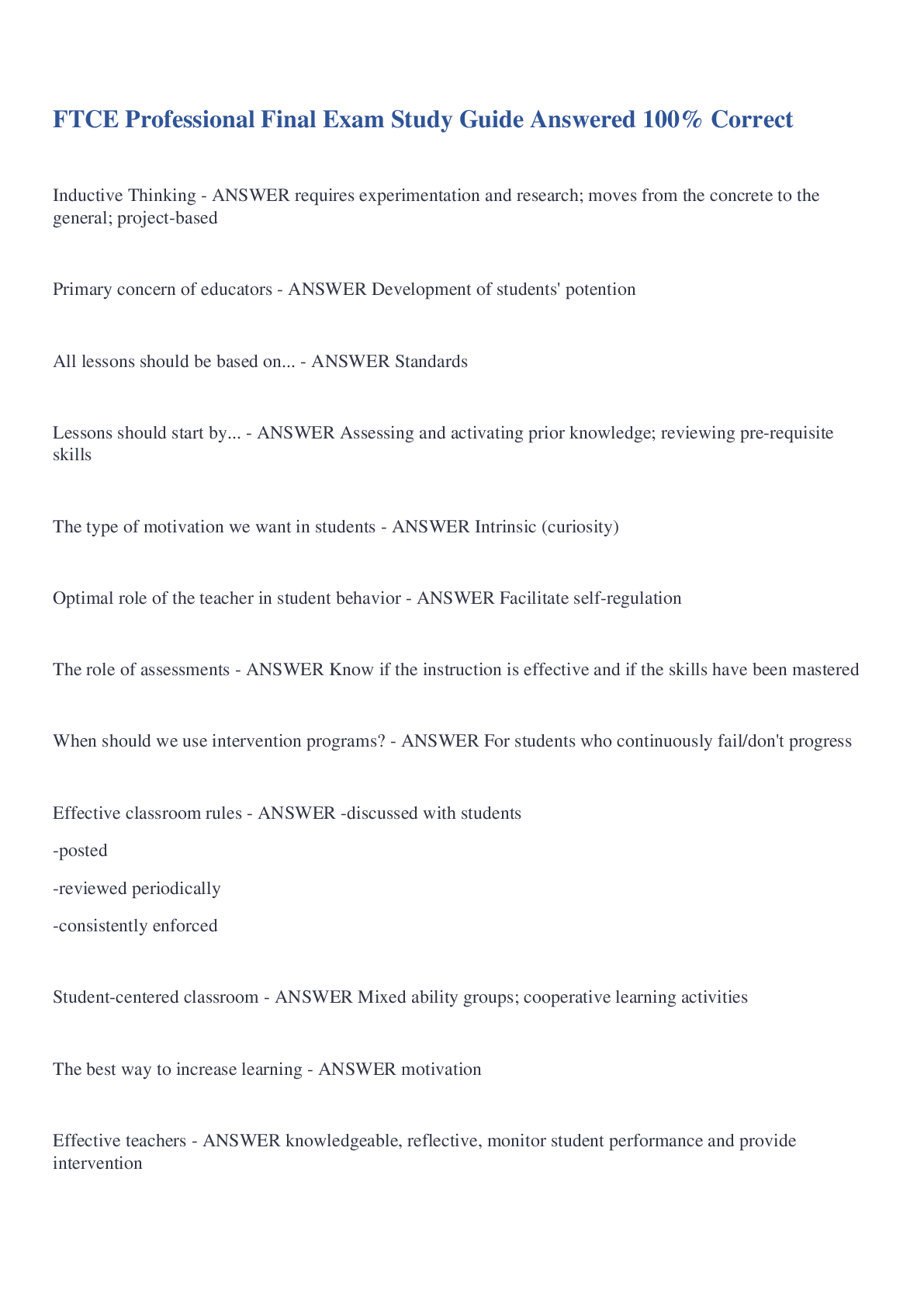
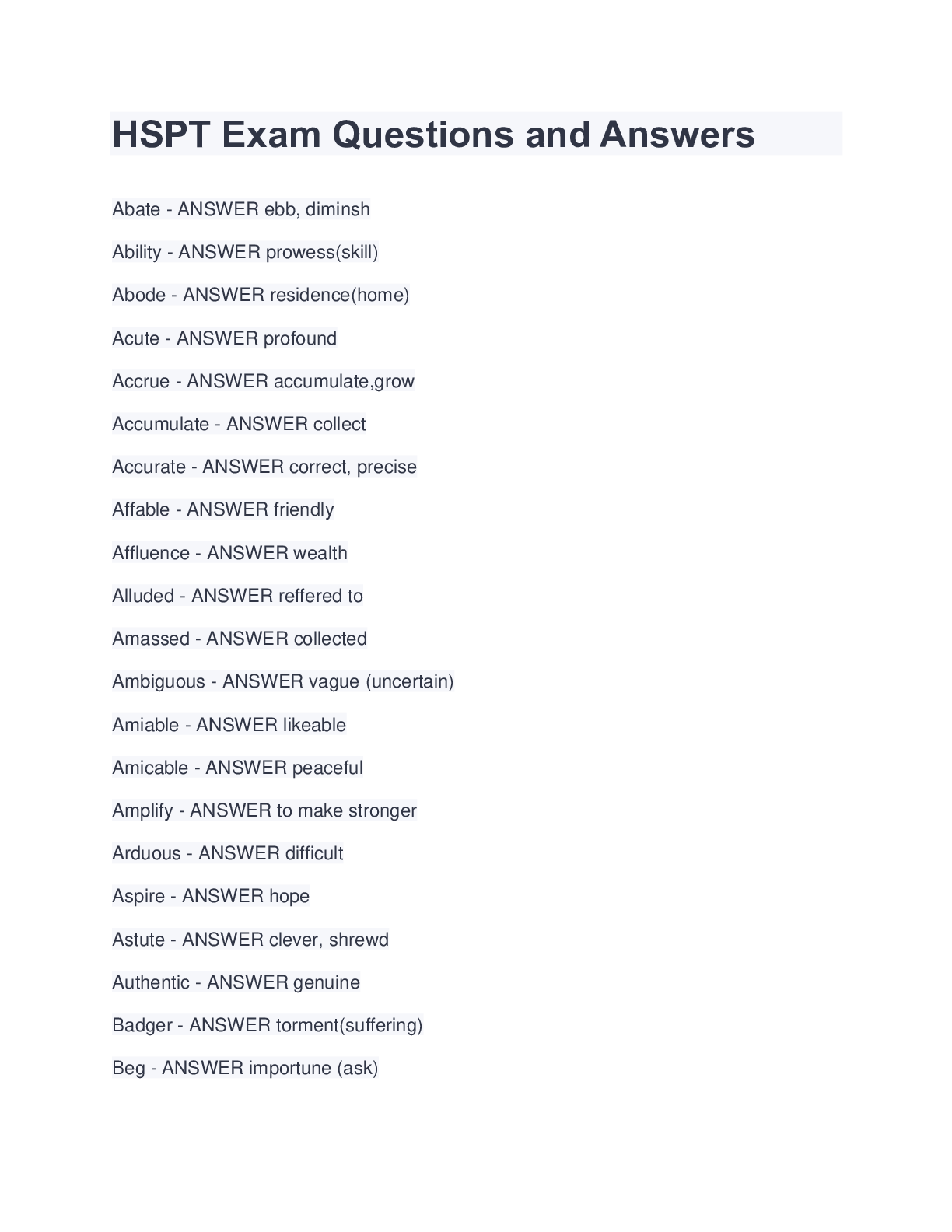
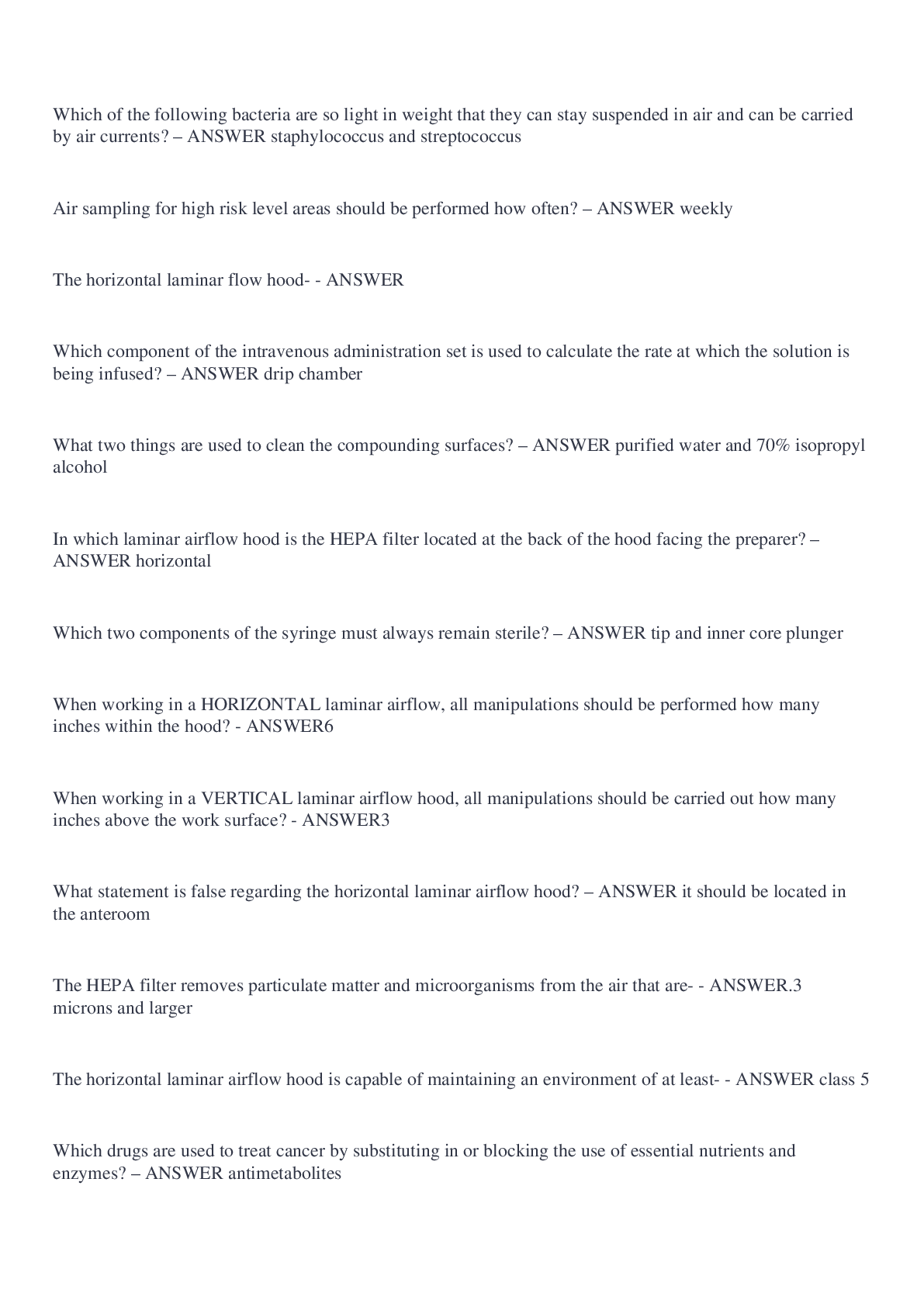

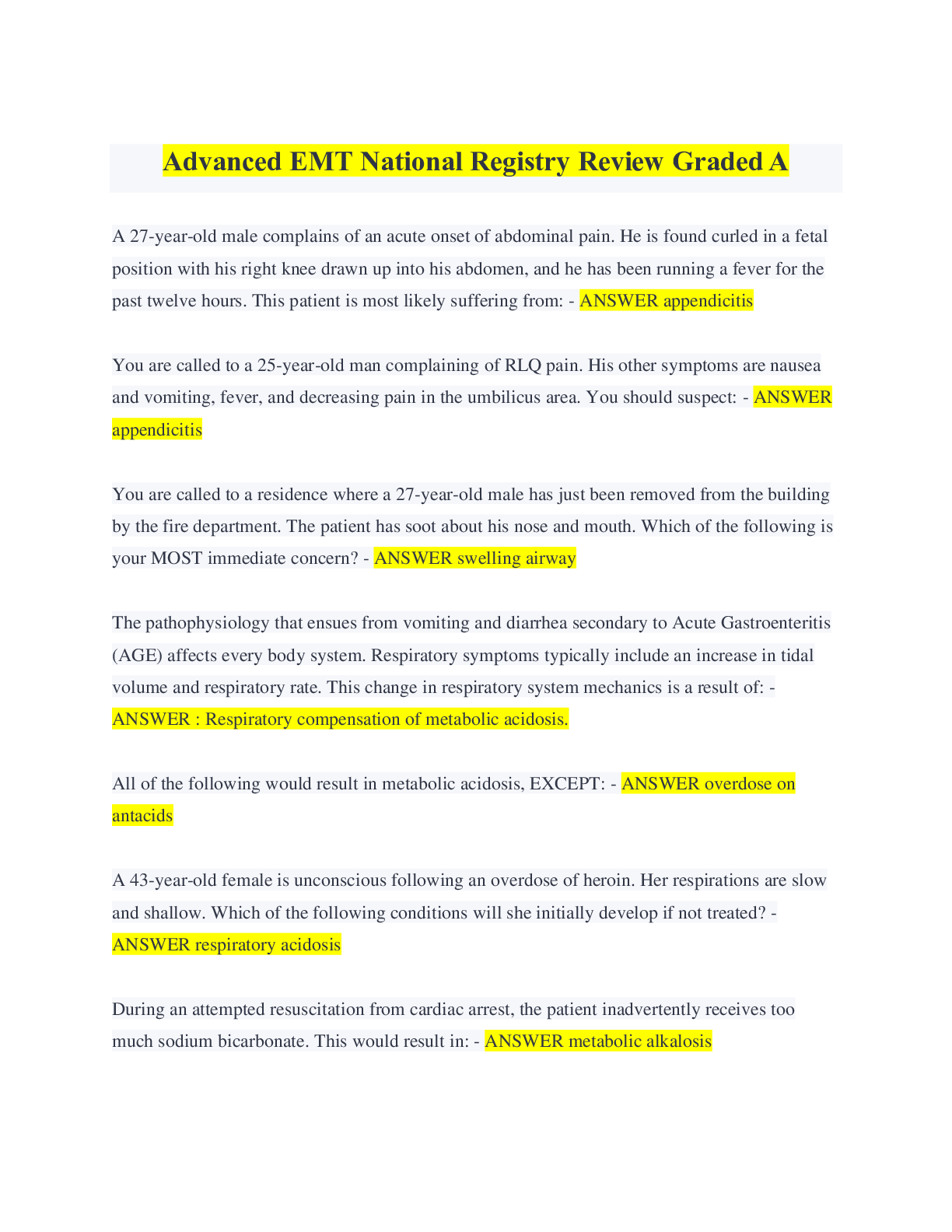
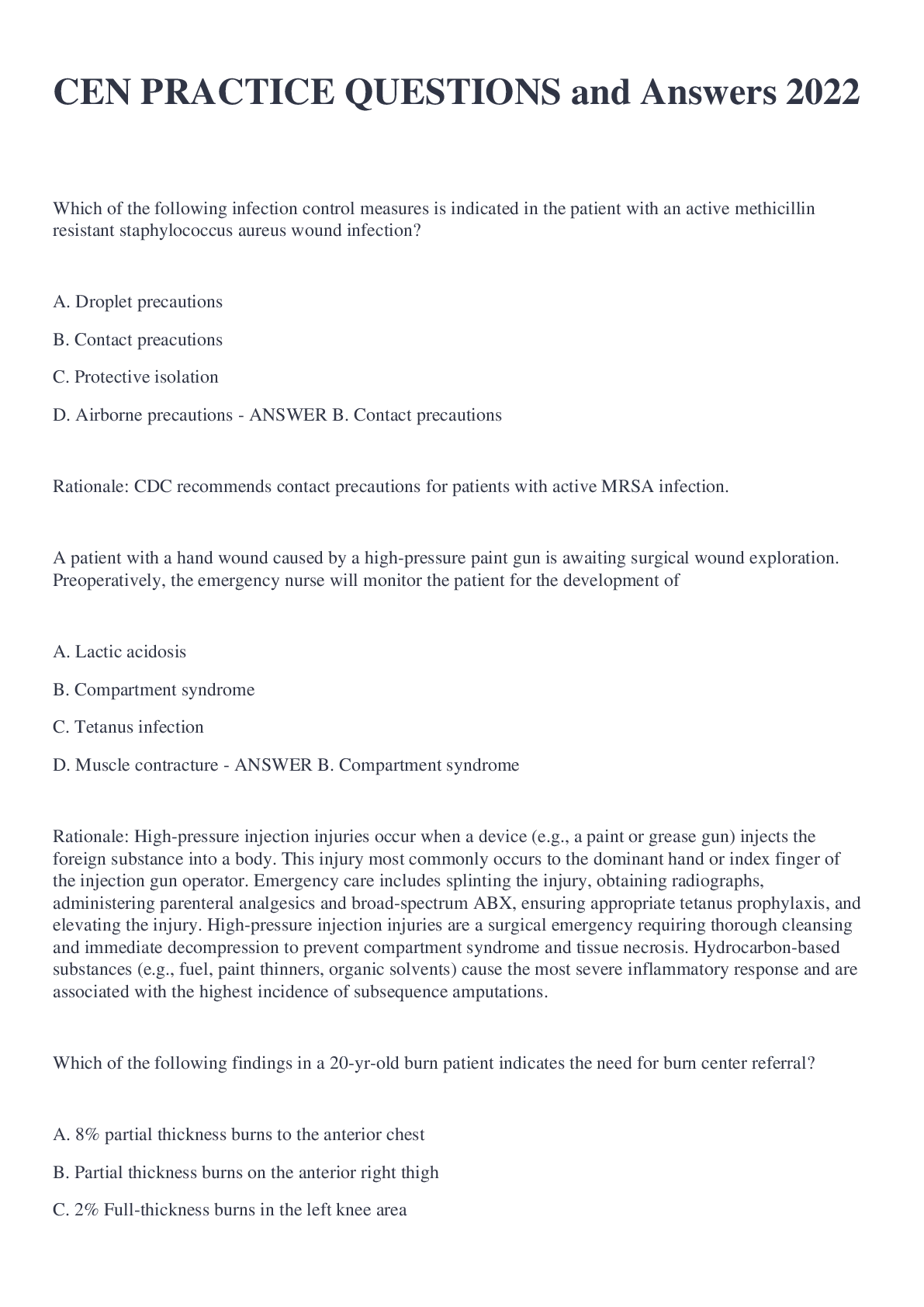
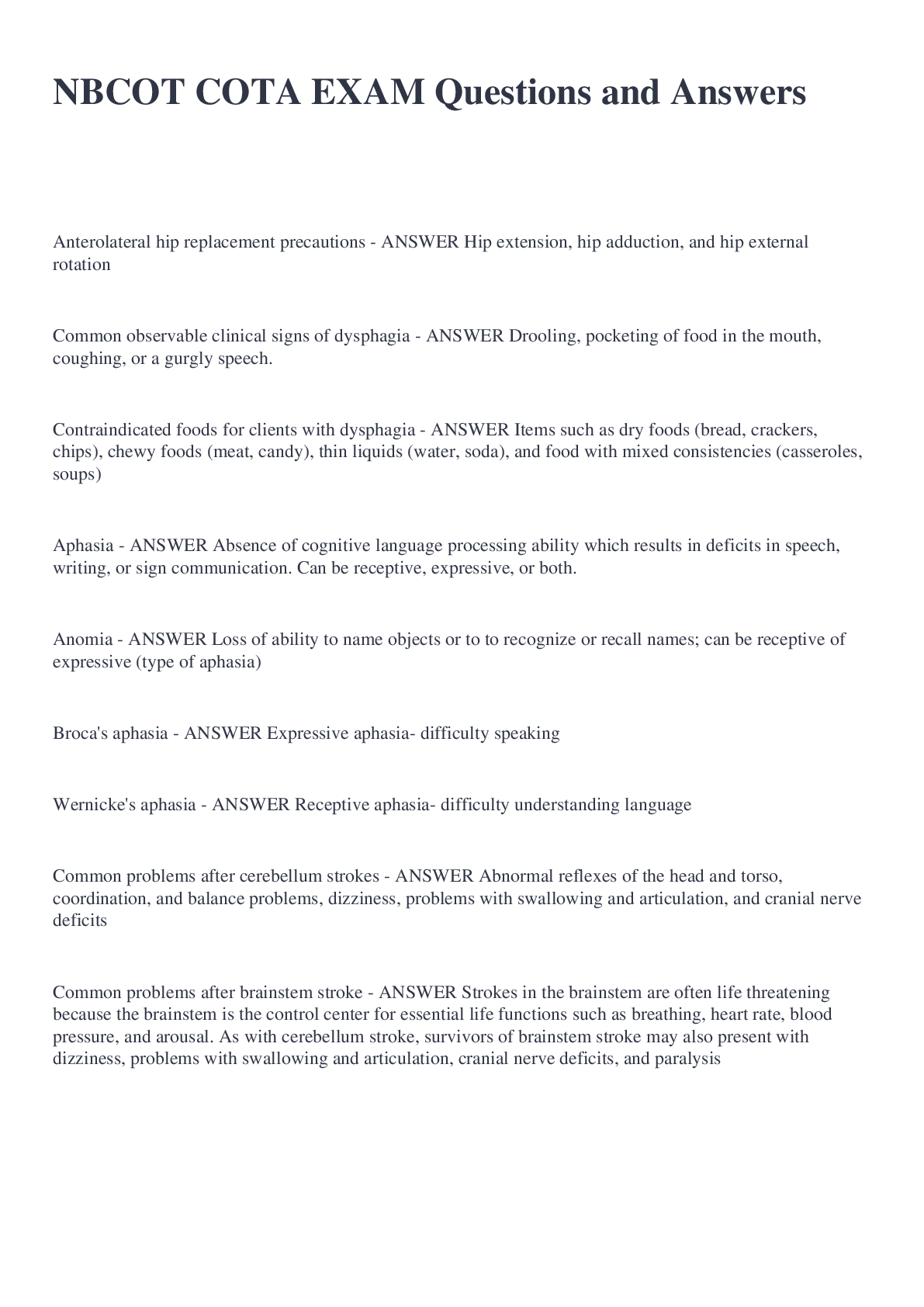
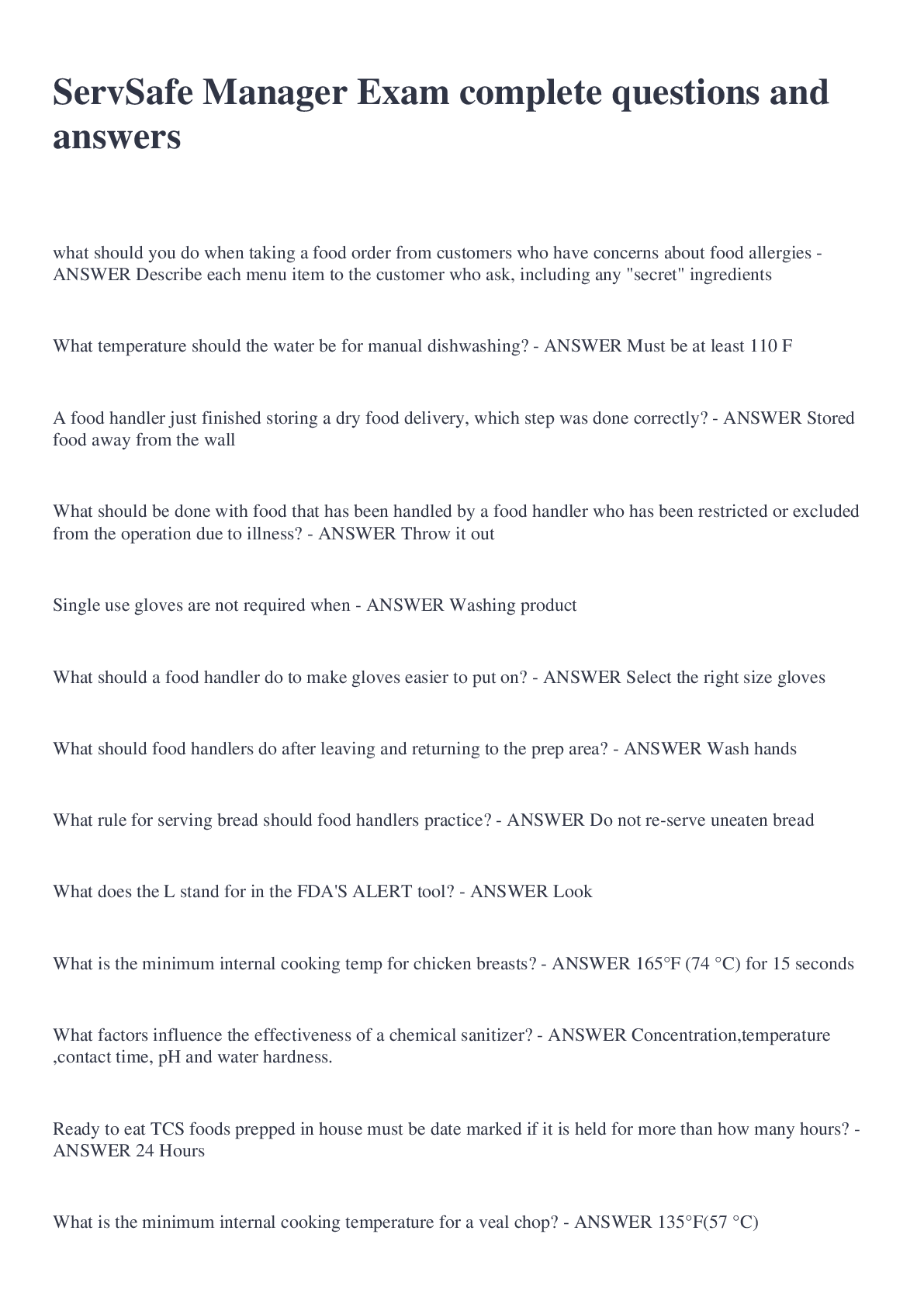
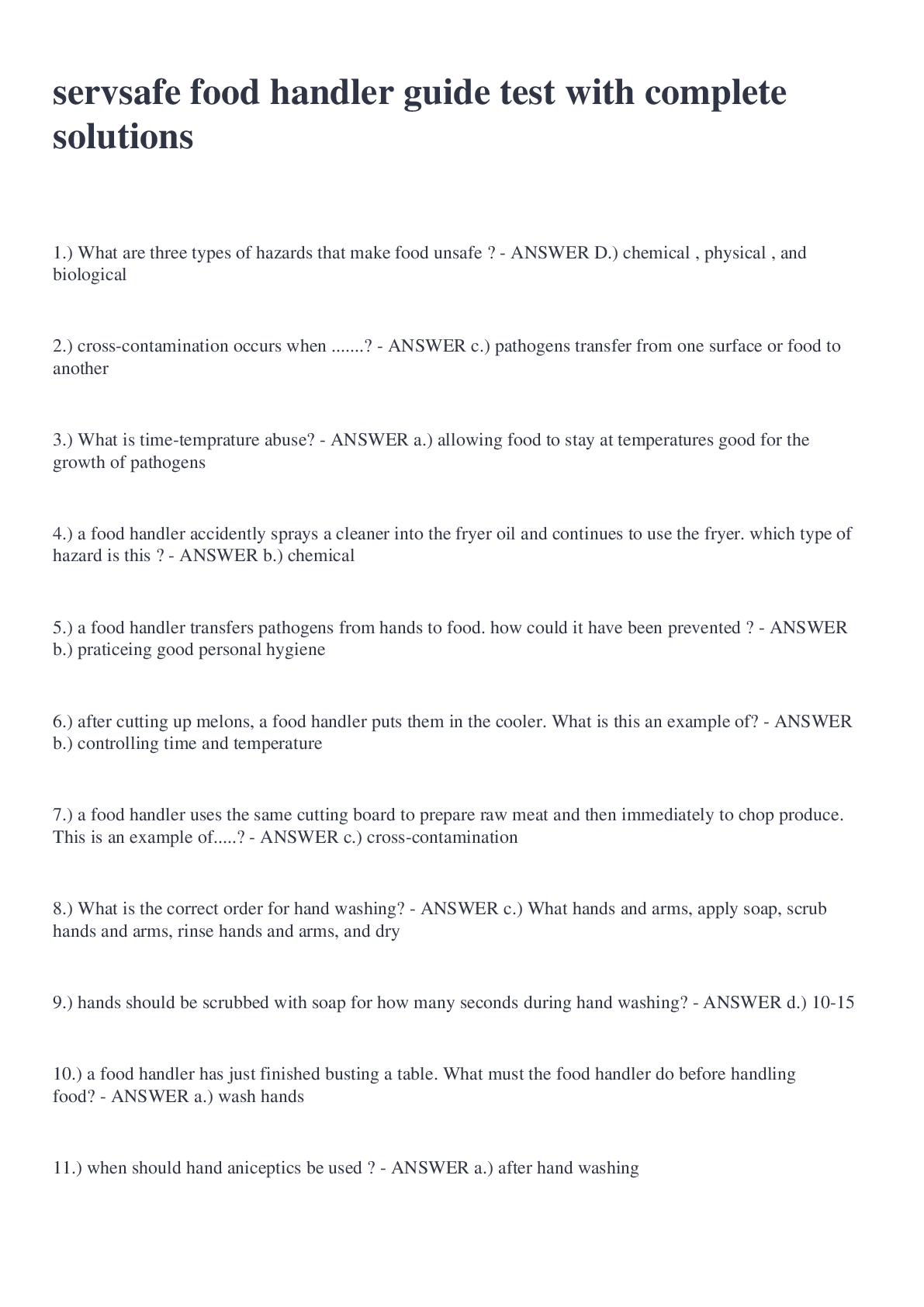
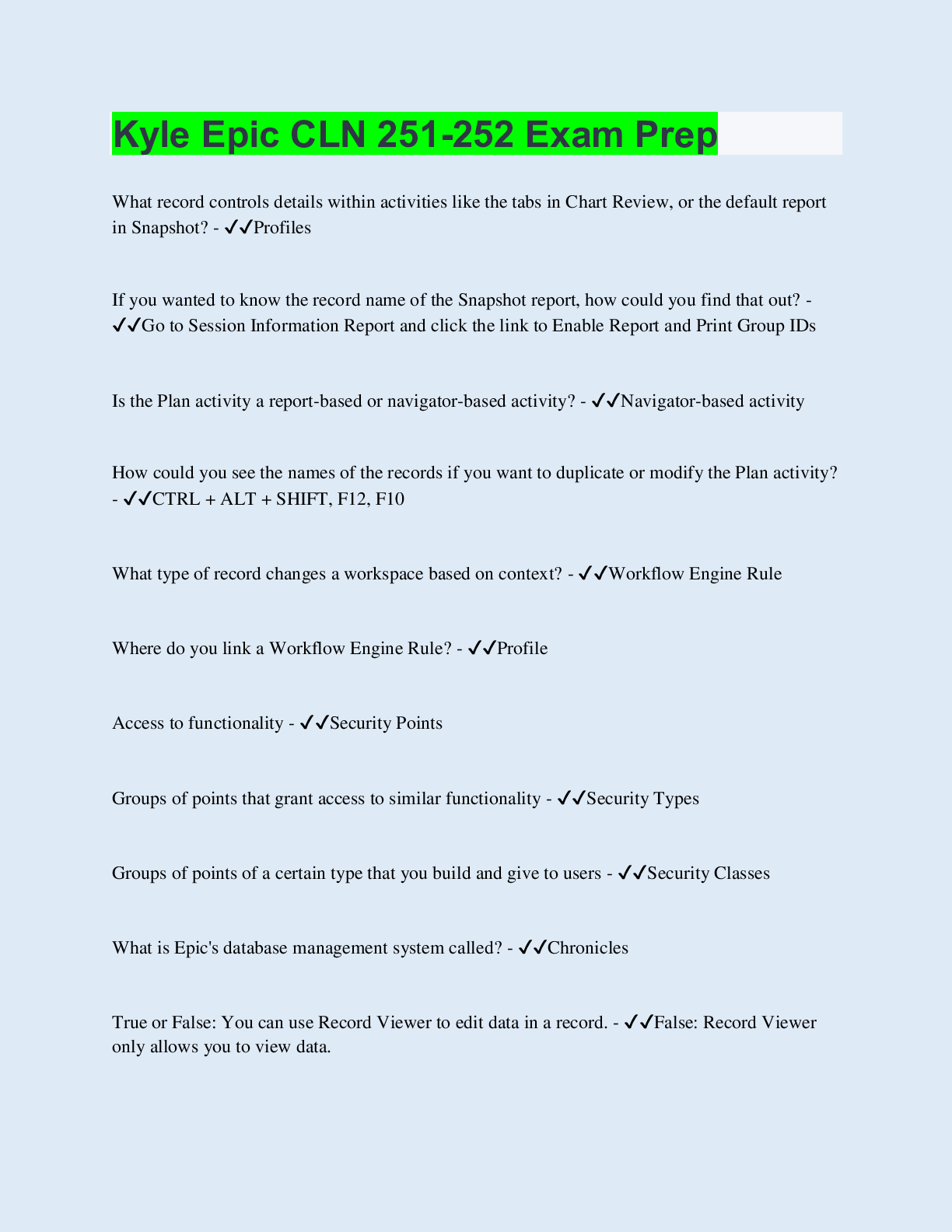
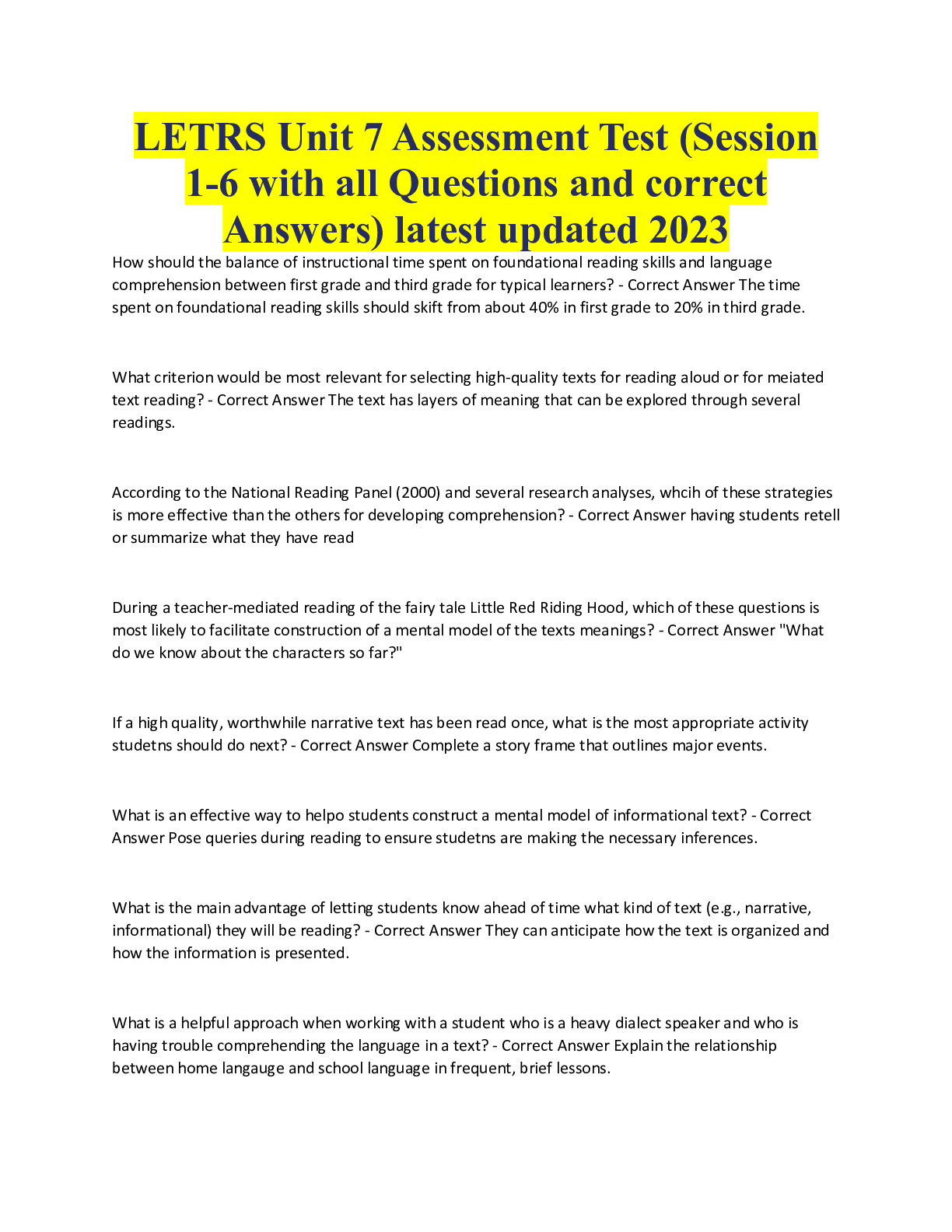
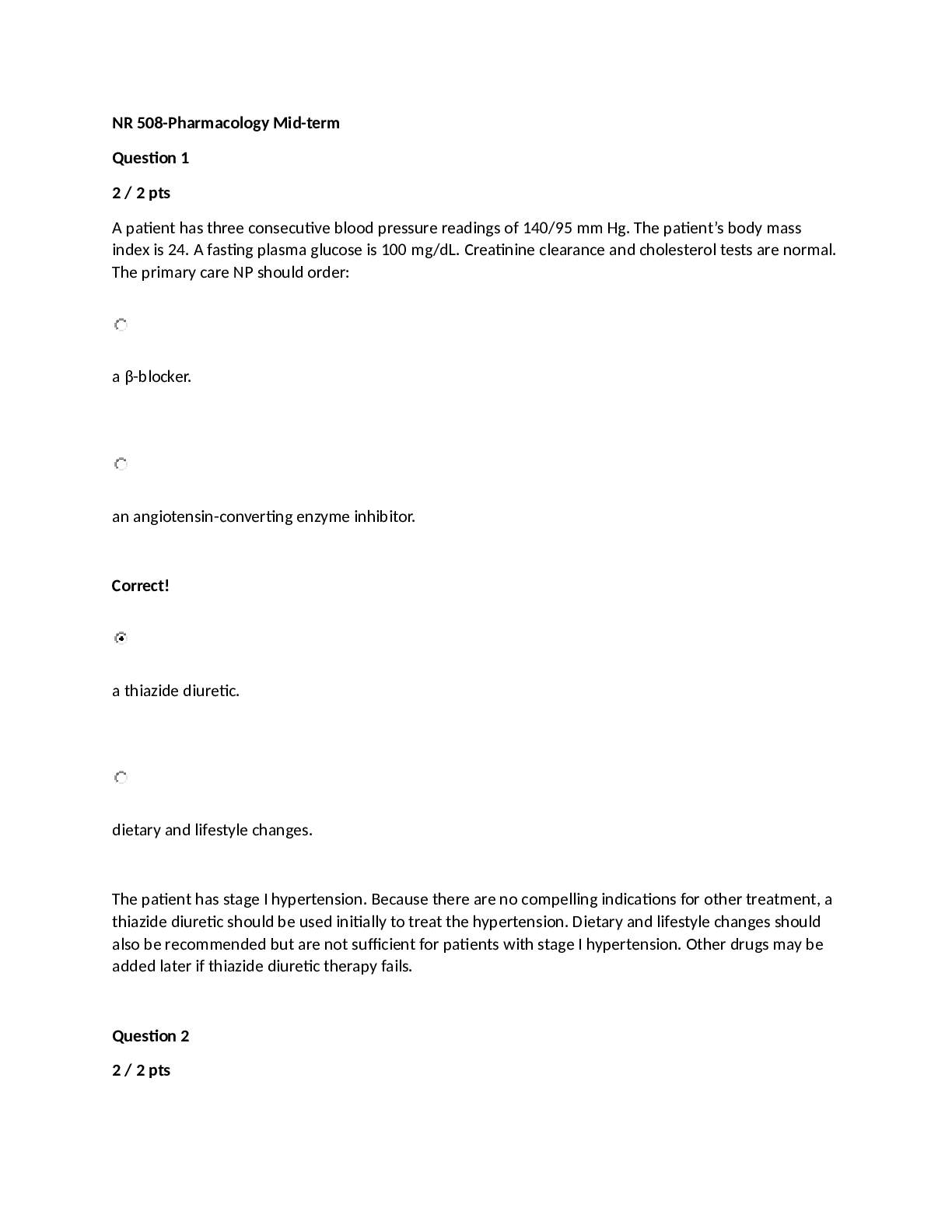

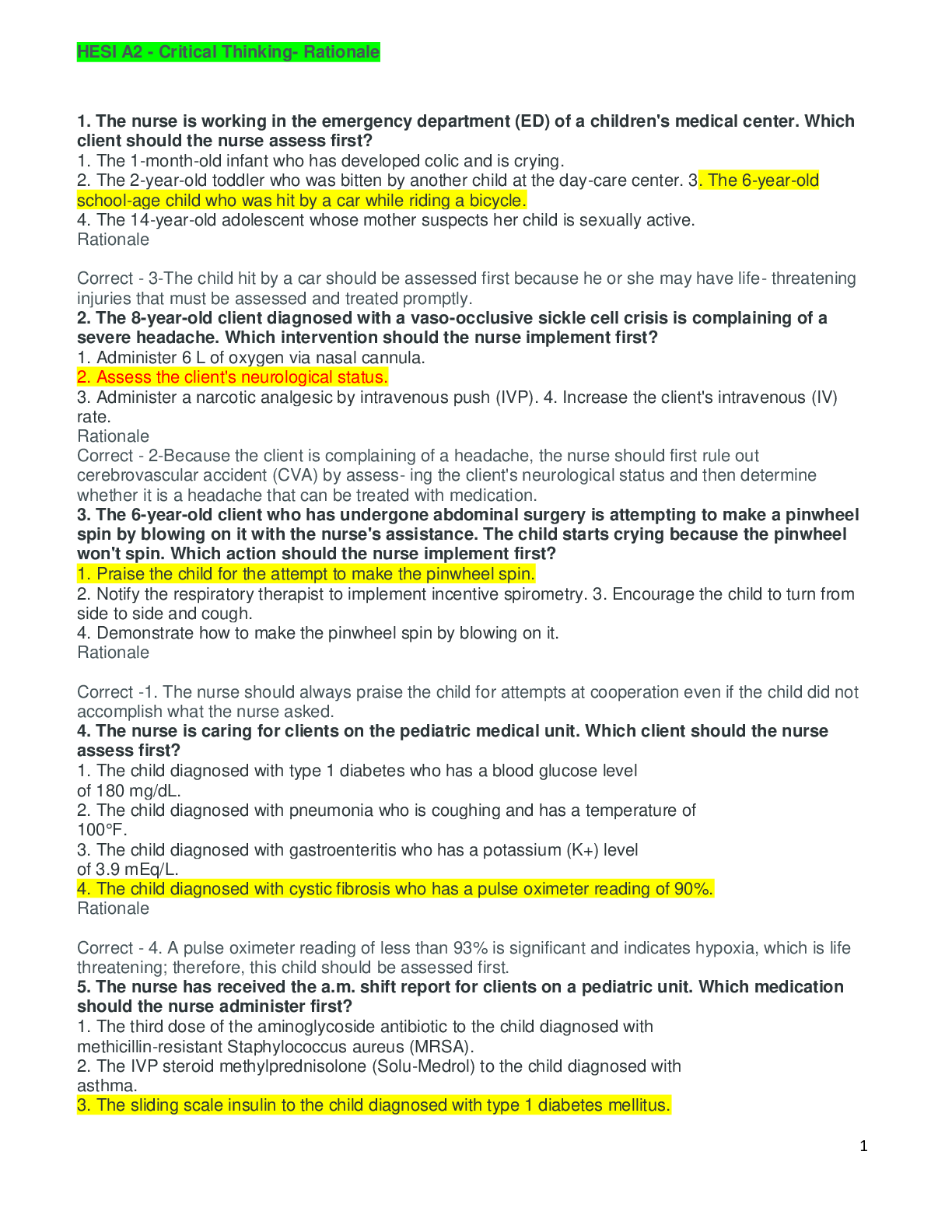

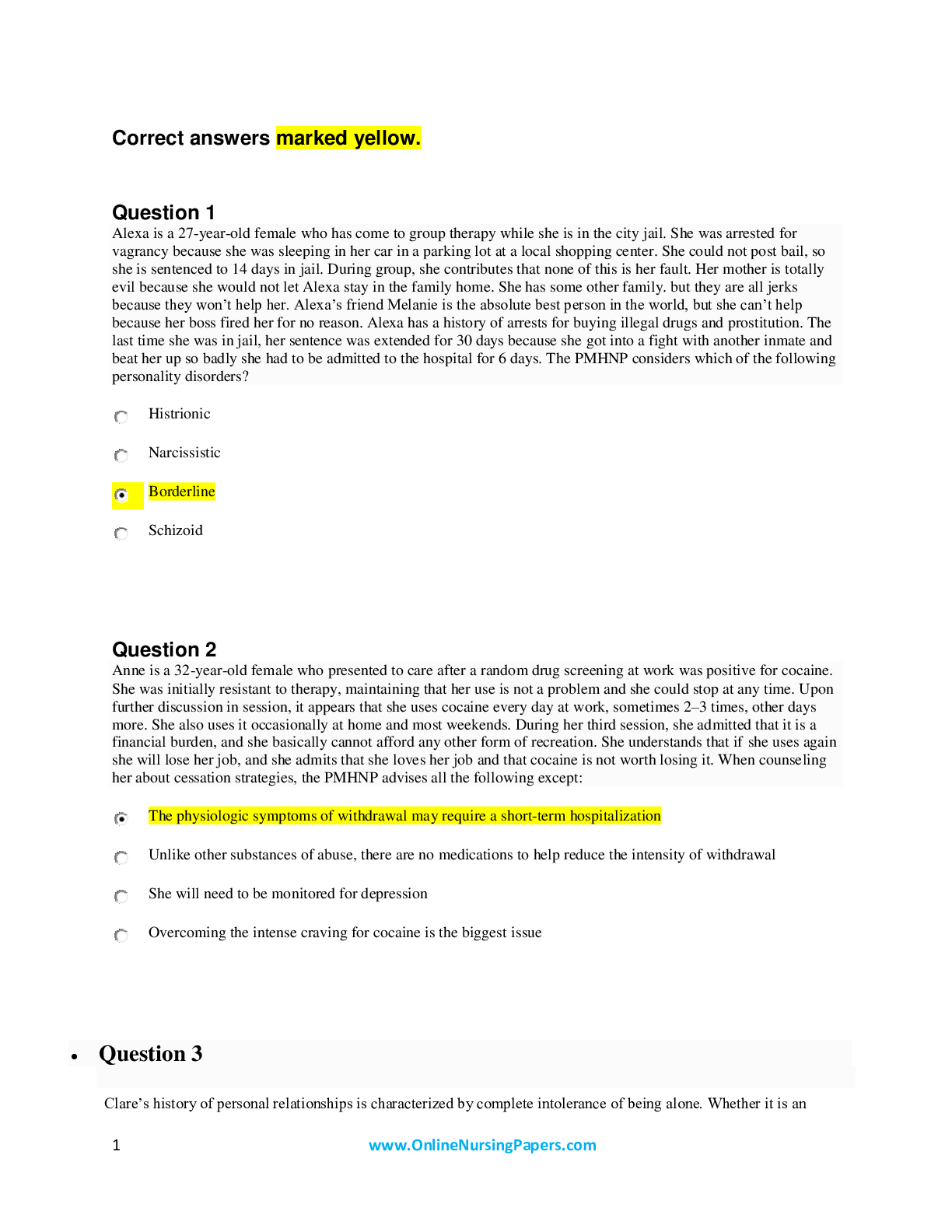
.png)



.png)



